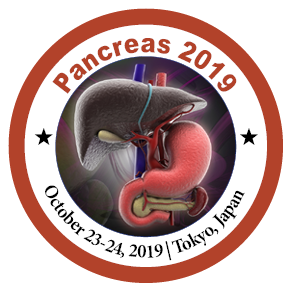Ripal T. Gandhi
University of South Florida College of Medicine, USA
Title: Targeted Intra-arterial Gemcitabine: Impact on Survival in Patients with Locally Advanced Pancreatic Cancer—A New Treatment Paradigm
Biography
Biography: Ripal T. Gandhi
Abstract
Introduction: Treatment of patients with locally advanced pancreatic cancer (LAPC) remain a clinical challenge. As intra-arterial (IA) chemotherapy has become a first-line treatment option for patients with hepatic tumors, targeting a similar approach to patients with LAPC is of interest. We have conducted two studies—a safety study (RR1) followed up by a registry study (RR2)—using a strategy of IA gemcitabine with local IA delivery catheter, RC-120, in this patient cohort. Here we update the clinical outcome of our patients with continuing follow up.
Methods: The initial RR1 study was a safety study of 20 patients that received dose escalated gemcitabine (Gemzar) ranging from 250-1000mg/m2 twice monthly. RR2 was a registry with 25 patients enrolled (2 patients rolled over from RR1) where patients received up to twice monthly gemcitabine at 1000mg/m2. In both studies, patients were to receive 4 monthly cycles with 2 IA therapies per cycle. Patients in both studies could be enrolled as long as they had locally advanced disease—with or without prior chemotherapy or chemoradiation. If they showed evidence of conversion to resectability, they went on to surgery. As a routine, time to progression was not measured once they left the IA therapy, but the data for survival was collected on all patients.
Results: 43 patients have been treated with IA gemcitabine using RC-120 catheter between the 2 studies from May 2015 to Dec 2018. The average age of patient enrolled was 69.9 years. Twenty-four of 43 patients had prior treatment before IA therapy: chemotherapy (n=11), chemoradiation (n=12), or prior surgery (n=1). The median gemcitabine dose was 1000mg/m2 and was administered to 33 of the 43-patient cohort. On average each patient received 4 IA therapy, ranging from 1-14. Thirteen of 43 patients completed the planned 4 cycles of IA therapy. For the patients that did not complete the 4 cycles of treatment the reason for early discontinuation was tumor progression (n=13), patient/physician preference (n=9), or severe adverse events (n=6). There is one patient still scheduled for ongoing IA treatments, and one patient had a reduction in tumor size, which led to resection of the pancreatic tumor.
In the overall cohort 6 of 43 patients are still alive; the median overall survival for the overall cohort was 12.4 months. Of note patients with prior chemoradiation showed the best clinical response in terms of tumor response (CT and tumor markers) and survival across both studies - achieving median survival of 27.8 months with 4 of 12 patients still alive.
Conclusion: Localized intra-arterial delivery of gemcitabine using RC-120 catheter demonstrates encouraging results in stabilizing local disease. This benefit is especially pronounced in patients with prior induction therapy with chemoradiation. These early results have led to the initiation of a 300-patient randomized study, TIGeR-PaC (clinicaltrial.gov #NCT03257033), comparing IA

